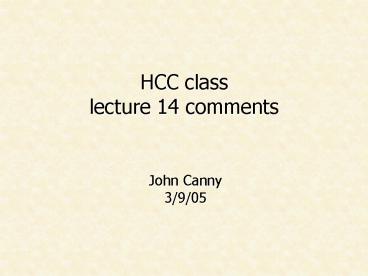HCC class lecture 14 comments PowerPoint PPT Presentation
1 / 15
Title: HCC class lecture 14 comments
1
HCC classlecture 14 comments
John Canny3/9/05
2
Administrivia
3
Clustering LSA again
- The input is a matrix. Rows represent text blocks
(sentences, paragraphs or documents) - Columns are distinct terms
- Matrix elements are term counts (x tfidf weight)
- The idea is to Factor this matrix into A D B
Themes
Terms
Terms
B
D
Textblocks
M
A
Textblocks
4
LSA again
- A encodes the representation of each text block
in a space of themes. - B encodes each theme with term weights. It can be
used to explicitly describe the theme.
Themes
Terms
Terms
B
D
Textblocks
M
A
Textblocks
5
LSA limitations
- LSA has a few assumptions that dont make much
sense - If documents really do comprise different
themes there shouldnt be negative weights in
the LSA matrices. - LSA implicitly models gaussian random processes
for theme and word generation. Actual document
statistics are far from gaussian. - SVD forces themes to be orthogonal in the A and B
matrices. Why should they be?
6
Non-negative Matrix Factorization
- NMF deals with non-negativity and orthogonality,
but still uses gaussian statistics - If documents really do comprise different
themes there shouldnt be negative weights in
the LSA matrices. - LSA implicitly models gaussian random processes
for theme and word generation. Actual document
statistics are far from gaussian. - SVD forces themes to be orthogonal in the A and B
matrices. Why should they be?
7
LSA again
- The consequences are
- LSA themes are not meaningful beyond the first
few (the ones with strongest singular value). - LSA is largely insensitive to the choice of
semantic space (most 300-dim spaces will do).
8
NMF
- The corresponding properties
- NMF components track themes well (up to 30 or
more). - The NMF components can be used directly as topic
markers, so the choice is important.
9
NMF
- NMF is an umbrella term for several algorithms.
- The one in this paper uses least squares to match
the original term matrix. i.e. it minimizes - ? (M AB)2
- Another natural metric is the KL or
Kullback-Liebler divergence. The KL-divergence
between two probability distributions p and q is - ? p log p/q
- Another natural version of NMF uses KL-divergence
between M and its approximation as A B.
10
NMF
- KL-divergence is usually a more accurate way to
compare probability distributions. - However, in clustering applications, the quality
of fit to the probability distribution is
secondary to the quality of the clusters. - KL-divergence NMF performs well for smoothing
(extrapolation) tasks, but not as well as
least-squares for clustering. - The reasons are not entirely clear, but it may
simply be an artifact of the basic NMF
recurrences, which find only locally-optimal
matches.
11
A Simpler Text Summarizer
- A simpler text summarizer based on inter-sentence
analysis did as well as any of the custom systems
on the DUC-2002 dataset (Document Understanding
Conference). - This algorithm called TextRank was based on a
graphical analysis of the similarity graph
between sentences in the text.
12
A Simpler Text Summarizer
- Vertices in the graph represent sentences, edge
weights are similarity between sentences
S1
S2
S7
S3
S6
S4
S5
13
Textrank
- TextRank computes vertex strength using a variant
of Googles Pagerank. It gives the probability of
being at a vertex during a long random walk on
the graph.
S1
S2
S7
S3
S6
S4
S5
14
Textrank
- The highest-ranked vertices comprise the summary.
- Textrank achieved the same summary performance as
the best single-sentence summarizers at DUC-2002.
(TextRank appeared in ACL 2004)
15
Discussion Topics
- T1 The best text analysis algorithms for a
variety of tasks seem to use numerical (BOW or
graphical models) of texts. Discuss what
information these representations capture and why
they might be effective.

